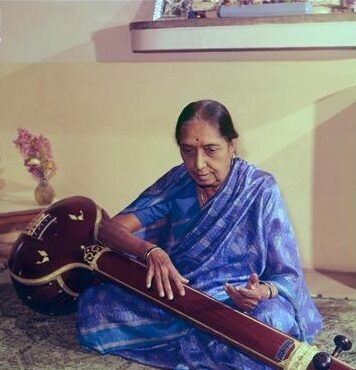Saraswati Abdul Rane: The Legendary Hindustani Classical Singer Who Shaped Indian Music
Saraswati Abdul Rane, born on October 4, 1913, in Miraj, Bombay Presidency (now in Maharashtra), was a renowned Hindustani classical singer whose immense contribution to the world of classical music has left an enduring legacy. She was the daughter of Ustad Abdul Karim Khan, the founder of the Kirana Gharana of Hindustani classical music, which marked her path in the world of music. A woman of exceptional talent, Saraswati Abdul Rane dedicated her life to preserving and promoting classical music, not only through performances but also by passing on her knowledge to the next generation.
Early Life and Family Background
Born as Sakina, Saraswati Abdul Rane’s childhood was steeped in music, thanks to her father, Ustad Abdul Karim Khan, who was a prominent figure in the classical music world. However, her parents’ separation led to her name change to Saraswati Mane as per her mother’s wish. Growing up in a family steeped in the musical tradition of the Kirana Gharana, Saraswati was naturally drawn to music. Her father’s legacy and the influences of her older siblings, especially Sureshbabu Mane and Hirabai Barodekar, set the foundation for her musical career.
From a young age, Saraswati was exposed to the intricacies of Hindustani classical music. Her elder brother Sureshbabu was her first formal teacher, and she later received training from some of the most renowned masters of the time. Her music education wasn’t confined to just the Kirana Gharana; she also sought guidance from musicians of other gharanas, including the Jaipur Gharana and Gwalior Gharana.
Musical Journey and Career
Saraswati Abdul Rane’s music journey began when she was just 7 years old, performing in the traditional style of Hindustani classical music. As a young girl, she was introduced to the stage through musical dramas such as Sangeet Sanshaykallol and Sangeet Saubhadra. At the age of 16, she began performing in major musical roles, sharing the stage with celebrated artists such as Balgandharva.
Her radio debut in 1933 with Akashvani was a turning point in her career. Saraswati continued to perform on Akashvani’s Radio Sangeet Sabhas until her retirement in 1990, bringing classical music to homes across India. She performed from Kanyakumari to Peshawar (now in Pakistan), popularizing classical music among the masses.
A trailblazer for women in classical music, Saraswati Abdul Rane became one of the first female vocalists to enter the world of commercial music. She made her mark in Marathi and Hindi cinema, with her first Marathi film song for ‘Payach Dasi’ and her Hindi film debut in ‘Ramrajya’. Her song for Ramrajya earned her the prestigious HMV Award for the highest sales of gramophone records. Her voice was widely loved, and she collaborated with famous filmmakers like Shyam Benegal in the 1977 film ‘Bhumika’.
Despite her success in cinema, Saraswati’s true passion remained with Hindustani classical music, particularly ‘Bhav-geet’ (light classical Marathi songs), which she sang with great finesse. Her records continued to sell even in the modern era, which speaks to the enduring appeal of her music.
Historic Jugalbandi and Performances
Saraswati Abdul Rane made a historic contribution to Hindustani classical music in 1965, when she performed in a jugalbandi (duet) with her sister Hirabai Barodekar. The performance was a monumental moment, as the duo became the first women to perform a jugalbandi recital in the history of Indian classical music. Their performances together were immensely popular and revered by both music connoisseurs and common listeners. The pair continued performing together until 1980, leaving behind a legacy of music that is still cherished today.
Throughout her career, Saraswati Abdul Rane was a regular feature at prestigious music festivals such as the Sawai Gandharva Music Festival in Pune and other significant conferences across Delhi, Bombay, Calcutta, and Madras.
Teaching and Legacy
In addition to her public performances, Saraswati Abdul Rane was deeply committed to the preservation and transmission of classical music. As a teacher, she imparted her knowledge to younger generations, ensuring that the tradition of Kirana Gharana would continue. Meena Faterpekar, Saraswati’s granddaughter, is one of the most notable students who carried forward the legacy of this renowned gharana.
Saraswati Abdul Rane’s commitment to the art of music was reflected in her ability to balance both a successful public career and a teaching role. She remained dedicated to Hindustani classical music and helped spread its influence throughout the country.
Awards and Recognition
Over her illustrious career, Saraswati Abdul Rane received several awards, acknowledging her contribution to Indian classical music. Some of the major awards she received include:
- Balgandharva Puraskar
- Balgandharva Gold Medal
- Yeshwantrao Chavan Puraskar
- Guru Mahatmya Puraskar
- ITC Sangeet Research Academy Award
- Kirana Gharana Award (1999)
She was also invited to perform during India’s first Independence Day celebrations in 1947 in New Delhi, a testament to her prominence and cultural importance. The Indian government and various cultural institutions consistently recognized her as a master of Hindustani classical music.
Personal Life and Death
Saraswati Abdul Rane was married to Sunderrao Rane, and together they led a life dedicated to music and culture. On October 10, 2006, Saraswati Abdul Rane passed away at the age of 93, leaving behind an indelible legacy in the world of Hindustani classical music.
Timeline of Key Events
- 1913: Born as Sakina on October 4.
- 1929: Started performing in musical dramas with Balgandharva.
- 1930: Began formal lessons from her sister Hirabai Barodekar.
- 1933: Debuted on Akashvani, marking the beginning of her radio career.
- 1947: Performed at India’s first Independence Day celebrations.
- 1965: Made history with the first jugalbandi performance with Hirabai Barodekar.
- 1990: Announced retirement from public performances.
- 1999: Received the Kirana Gharana Award.
- 2006: Passed away on October 10 at the age of 93.
Conclusion
Saraswati Abdul Rane’s life and work left an indelible mark on the world of Hindustani classical music. As an artist, teacher, and trailblazer, she not only contributed to the preservation of Indian classical traditions but also played a key role in shaping the music industry, both on stage and through cinema. Her legacy continues to inspire musicians, students, and music lovers alike, proving that the power of music transcends time and generations. Her work will forever be etched in the hearts of those who appreciate the beauty and depth of Indian classical music.
Frequently Asked Questions (FAQs)
- What is Saraswati Abdul Rane’s contribution to Hindustani classical music?
- Saraswati Abdul Rane was a renowned classical singer known for her mastery of the Kirana Gharana and her efforts to popularize Hindustani classical music through performances and radio shows. She was also a pioneer in promoting Bhav-geet in Marathi music.
- What awards did Saraswati Abdul Rane receive?
- Saraswati Abdul Rane received numerous prestigious awards, including the Balgandharva Puraskar, ITC Sangeet Research Academy Award, and the Kirana Gharana Award.
- How did Saraswati Abdul Rane impact Marathi cinema?
- Saraswati Abdul Rane lent her voice to numerous Marathi and Hindi films, making significant contributions to the music industry. Her song in the film ‘Ramrajya’ earned her the HMV Award.
- What was Saraswati Abdul Rane’s role in teaching classical music?
- Saraswati Abdul Rane taught Hindustani classical music to the younger generation, ensuring that the legacy of the Kirana Gharana continued. One of her notable students was her granddaughter Meena Faterpekar.
- When did Saraswati Abdul Rane retire from public performances?
- Saraswati Abdul Rane retired from public performances in 1990, after a long and successful career that spanned several decades.










